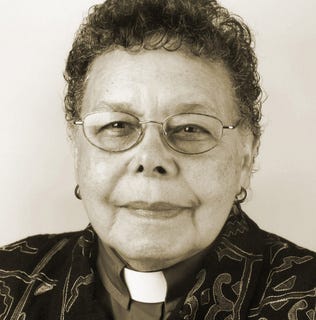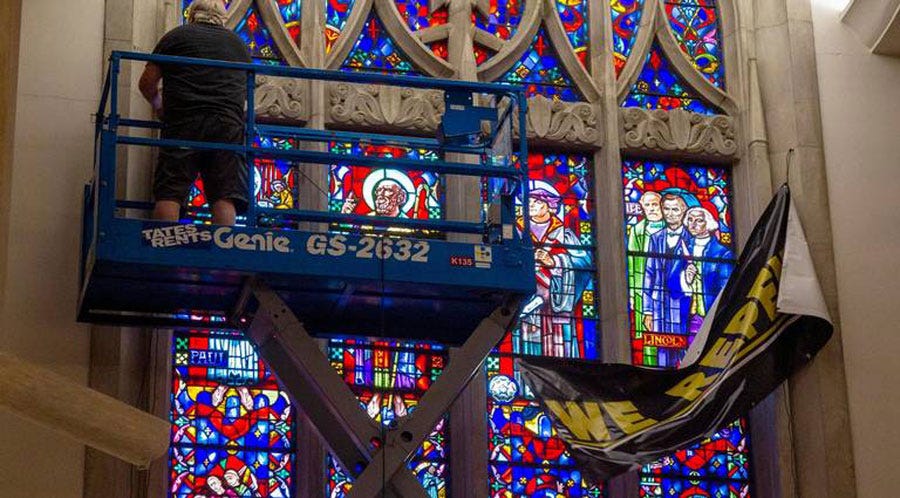Why Removing Racist Symbols and Monuments Matters
Many scoff at the idea of taking down racist monuments and artifacts, but symbols shape narratives and matter greatly in the struggle for racial justice.
A United Methodist (UMC) church in Idaho recently took down one of its stained glass windows depicting Confederate General Robert E. Lee. They replaced it with a stained glass window featuring the first African American bishop of the UMC, Leontine T. Kelly.
Leaders of the congregation decided to remove the window in 2020 as they reflected on the five-year anniversary of the Emanuel Nine church shooting and in light of the historical racial justice uprisings that year. They hope the old window will be housed in the Idaho Black History Museum.
In recent years, groups and organizations nationwide have engaged in efforts to remove racist imagery and monuments from public and religious spaces.
In 2015, community organizer and artist, Bree Newsome, was arrested for climbing the flag pole in front of the South Carolina statehouse and taking down the Confederate flag flying in front of it.
In 2017, activists in Memphis prevailed in their battle to bring down a statue of Confederate General and slave trader, Nathan Bedford Forest, from a popular park in the city.
In 2020, the Quaker Oats company finally relented to public pressure and decided to remove the “Aunt Jemima” figure from its line of pancake and syrup products. They acknowledged that “Aunt Jemima’s origins are based on a racial stereotype”—a stereotype that imagined Black women as perpetual servants of white people.
Some may object that such changes are merely symbolic. They don’t result in the substantive changes needed to meaningfully change outcomes for Black people and other people of color for the better.
What does changing a picture or taking down a statue do about the crisis of mass incarceration, the increasing obstacles to free and fair voting, the underfunding of public schools that serve predominantly Black and brown student populations?
Switching symbols does not seem like a persuasive way to change the racial landscape of the nation. In a Pew Research survey from September 2020, 86 percent of Black respondents indicated that the country hasn’t made enough progress on racial equality. Just 39 percent of white respondents agreed that not enough progress has been made.
Do symbolic changes really matter?
Yes. They do.
Symbols tell stories. They shape narratives. They craft the contours of the social imagination.
When a church installs a stained glass window celebrating a Confederate general, it is communicating who matters, who is applauded, and who is considered an example. Worshipers congregating in the sanctuary Sunday after Sunday receive the message that slaveholders and violent seditionists are figures who exemplify Christian faith and practice.
The same is true in public spaces. The Confederate monuments and symbols that have dominated downtown squares, cemeteries, and even university campuses send a clear signal about who the space is meant for and who is considered “other” or inferior.
If stories matter then symbols matter, too. This is not a denial that other changes need to occur. By all means, protect the vote, close the racial wealth gap, and reimagine public safety.
Do not be content with shifts in image but not in substance.
But don’t let the fact that the work remains incomplete minimize the importance of symbols and the stories they tell.
Every time a racist image or symbol is removed from a public display, it creates the space for other, more inclusive and righteous, tales to be told. It expands the social imagination to include a broader picture of who should be emulated, elevated, and commemorated.
At the same time, removing racist symbols allows them to be placed in a setting that tells a truer story. By placing a stained glass window or a Confederate statue in a museum, these artifacts can be placed in their proper historical context. Viewers leave with a more accurate picture of the national narrative around race and can use such information to make better choices in the future.
An enormous amount of racial justice work remains unfinished. In fact, the forces of opposition have arrayed themselves with renewed vigor to protest progress. It would be foolish to argue otherwise.
Even with all the other more complex work that needs to be done, part of the labor of racial justice is shifting perspectives and reshaping ideas. This is the importance of symbols and why changing them matters.



